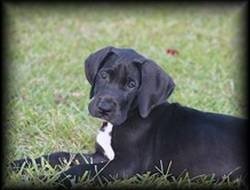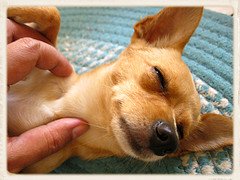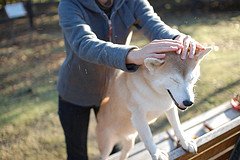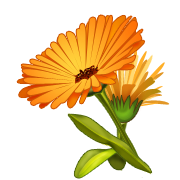
|

|
|
|
| ||
Dog MassageDog massage has become widely accepted and recognized by the veterinary community. Photo Courtesy of jaraos  Like humans, dogs often experience soreness and muscle stiffness, with the occasional soft tissue injuries and associated pain. Regular dog massage can help prevent these problems in your dog, keeping her flexible and muscle-stress free. Today, animals play different roles and live longer. Regular massages can help to ensure they have a healthy life. All kinds of dog can benfit from dog massage: young, mature adults, and geriatrics as well as the obese. When dog massage is used in palliative care, such as hip replacements, dog massage can shorten recovery time and achieve better results. It also can help curb behavior issues. Regardless of the massage techniques used, regular massage contributes to overall well-being. It relaxes the nervous system, helping self-regulation factors betweeen body and mind. Resources: Dog Fancy Magazine Pet message-a form of massotherapy for animals notable for its gentleness, nurturing and support of the body's naturally powerful inclination toward balance and harmony. Dog Massage helps you get acquainted with your dogs body and can help you detect problems early on. Massage is a natural process that you can use to help your dog maintain a better quality of life. It gives him the means to live his life to its fullest potential. Dog massage techniques are simple to learn and have so many benefits for you and your dog. A Dog massage gives you the opportunity to give your pet a head-to-tail checkup, to look and feel for things that don't belong on your pet. For example: abrasions, bumps, tenderness, and sores, plus parasites, burns and foxtails or ticks that have found their way onto your pets furry coat. Not to mention you will also be able to detect any bumps or lumps that should not be there. A weekly dog message is easy to do and can help you bond with your canine. Deep massage should be done only by a trained and certified practitioner so it's very important to always keep your home massage light and gentle. A gentle home massage can give your dog comfort as well as aiding the nervous system and increasing circulation. When to Begin Giving Dog MassageOwners should get their pups used to being touched at a young age. Start as soon as you bring the puppy home. Teach your pet to give you him paw so that it can be examined and his nails easily clipped. Good whole body pats and rubs will get your pup used to being handled. Also get your dog accustomed to having your finger in his mouth. This will enable you to brush his teeth, remove unwanted items, and check the color of his gums. Dog Massage Techniques Use a very light oil. (I recommend Neutrogena Light Sesame Body Oil but baby oil is O.K.) Rub a very small amount (the size of a dime) into your hands and start at the top of the head and slowly stroke down the back to the base of the tail 3 - 4 times. Do an additional 2 - 3 times including the tail this time all the way to the tip. Use a very gentle but firm "squeeze-grip" on the tail as you slide your hand down to the tip, starting with a pause as you squeeze at the base of the tail, keeping your grip all the way to the tip of the tail. Next, gently rub the back of the neck behind the ears with your forefingers for a few seconds. Then, hold your dog's head in your hands by the cheeks and under the ears (with the dog facing you) and rock the head gently side-to-side 4 - 5 times. Massage the ears, taking care when you finish by inserting the tip of your thumb into the ear (about 1/8") and rub the ears between your thumb and forefinger. Massage your dog's eyes (they will close automatically) very lightly with your thumbs and stroke your forefinger down the nose, starting between the eyes. Gently pinch your dog's cheeks and lips several times and finally stroke the throat and chin. Add a drop more oil to your hands and massage the chest (while the dog is standing), moving your hands under the armpits and rubbing gently. Allow your hands to slide from the armpits to the forelegs. Slide your hands down the forelegs (like you did for the tail) with a soft but firm grip all the way down to the paws. Gently hold the paws (one at a time) and squeeze gently for a few seconds. Repeat this procedure, starting with the chest, 2 - 3 times. *A note: It is best to straddle your dog standing over him like you would sit on a horse when you start with the chest massage (don't sit on him!!!). Then turn the opposite direction and massage the buttock, sliding your hands down the hind legs and massaging down to the paws. (Just as you did for the forelegs.) You can also massage the chest, armpits, legs and paws while your dog is laying down. Either on his side or on his back. And during the whole procedure, speak to your dog in a sweet, soft voice.......... This excellent information on massaging your dog was written by Kimberley Schreyer. The wonderful thing about canine massage is that it is a non-invasive and nurturing way to bring pain relief to your dog. Massage, whether for humans or animals, is a means of preventive health. Massage on your dog can positively impact every system in the body...muscular, skeletal, circulatory, nervous, digestive, integumentary and reproductive. This article will be discussing the benefits of massage on your dog's muscular system, in particular. Benefits of canine massage on your dog's muscular system include, but are not limited to, the following:
The muscular system is a very strong force within the dog's body. When these muscles are constricted or tight, that area of the body becomes lacking in proper blood flow. Due to this lack of blood flow, movement can become restricted, and the area becomes painful. Without relieving this pain, the muscles will tighten even more, the body gets out of balance, and the problem escalates. Massage for your dog can release these tight muscles, and get the circulation flowing smoothly once again. With this improved blood flow come the nutrients needed for the healing process. And, if a check-up by the vet has shown nothing, chances are that it is a muscular problem, and massage will help your dog recover quickly. How to Massage an Arthritic DogBy Jean-Pierre Hourdebaigt Common in senior dogs, arthritis is a degenerative joint disease that can cause pain and soreness in the hips, lower spine, hock, and knees, and to a lesser degree the shoulder and elbow. Spending a few minutes massaging your dog’s aching muscles can help relieve some of the pain of arthritis. Your massage session should last 10 to 15 minutes, but may be longer if your dog is a large breed. Start by lightly stroking the area you are about to massage. Follow with several effleurages – light strokes with very little pressure – to get the circulation going. Next, use a very light kneading motion over the tight muscles, as well as some very light hand friction to loosen the muscle fibers and stimulate deeper circulation. Intersperse with effleurages regularly – about every 10 seconds – to assist drainage. Do not work directly over the joints afflicted with arthritis, but rather, around them to stimulate circulation. Consider doing gentle stretching exercises either during or at the end of your massage sessions to maximize the flexibility of the tissue and joints you are working on. When done, gently stroke your dog’s entire body to help her relax. If you notice your dog’s joints appear inflamed after a massage, wrap a cold wet towel around the affected area to soothe and lower the inflammation. If inflammation persists, consult your veterinarian. Exercise in moderation is excellent for any arthritic condition. Follow your morning massage session with mild exercise such as a short walk, but avoid a strenuous workout. Although arthritis is incurable, applying simple massage techniques can help ease your dog’s aches, and she’ll benefit from the extra time spent with you! Jean-Pierre Hourdebaigt is a licensed massage therapist and author of Canine Massage: A Practical Guide (Howell) and Canine Massage: A Complete Reference Manual (Dogwise). A Head-To-Tail-CheckupEyes and EarsGently clear ears of dirt and waxy debris with ear wash or a soft cloth (never use a cotton swab, as you may penetrate too deeply and possible damage the ear canal.) If you discover redness, a foul odor, or what looks like coffee grounds, have your vet take a look. These could be a sign of a fungal infection or ear mites. If your dogs eyes water excessively, have a thick discharge, or he’s rubbing at them, flush with a saline solution. Lift the upper lid and drizzle from the outer corner so that fluid and debris run toward his muzzle. If there is still a problem, take your dog into bright sunlight. A corneal lesion will cause severe squinting of the affected eye. Keep him in a dark room until you can get him to your vet, as it will lessen your dog’s pain as the eye dilates. Compare your dog’s eyes for any differences, making sure both pupils are equal size. When they are not, your dog may need prompt medical attention for anisocoria. Nervous system abnormalities, infection, inflammation, cancer, and trauma can cause this condition. MuzzleAs you continue your check, feel your dog’s muzzle for bumps and tenderness. Due to bone and cartilage in the snout, it may be impossible to feel a growth. If it seems tender to the touch or there is an unusual discharge from the nostrils, get him to your vet. Next, have a look inside your dogs mouth. His gums should be a healthy pink (unless your pet has black has black gums, like chows and black labs) with no bad odor coming from the mouth. An unpleasant scent could mean gum disease, tooth decay, or even gastrointestinal problems, so don’t take doggie breath lightly. Check your dog’s circulation by pressing your index finger on the gum line to lighten the area. When you release pressure, color should return in 1 or 2 seconds on a healthy pet. Also notice if your dog’s gums are wet. If so, your dog is well-hydrated, If they are dry or sticky, get your dog to drink more water. BodyWhile massaging your dogs chest you should be able to feel, but not see, the ribs. His breathing should be steady, between 20 and 40 breaths per minute. Use long, soothing strokes with minimal pressure while rubbing his chest. Inspect legs and paws, making sure pads are not cracked and nails are trimmed. Dogs usually do not like to have their paws handled, so if that is the case with your dog just do a quick inspection and then let the paws go. Remember, this is supposed to be relaxing for your dog not a struggle. Next, stroke your dog’s abdomen with your fingertips, feeling for hard spots and sensitive areas. Check mammary glands, genitals, and under the tail. All should be clean with no colored discharge. If you notice scooting or impacted anal glands, ask your vet or groomer for assistance. Throughout your Dog massage and assessment, notice your pet’s skin and coat, is it flaking or excessive shedding? The right brush can feel like a massage and help stimulate oil glands. Examine your pets tail for pumps and sores; the area right above the tail often harbors parasites. If you notice anything that’s not quite right, call your veterinarian. After you finish give your dog a treat and lavishly praise him, let him know what a good boy he is, that is if he is awake. Give the gift of massage to your dog. She will love you for it! Table of Contents | Click Here To Visit Kittys Corner  Click Here to Vote for My Site! Click Here to Vote for My Site!
Benefits of A Dog Massage
 Top 3 Indicators to Look For During Your Dog MassageTufts University Professor Mary Anna Labato, D.V.M, believes the three most important things to look for are: Conditions of the coat: A sick dog may not be up to keeping himself well-groomed. A stinky, oily coat can be caused by several ailments that only your veterinarian can determine for sure. It could be an indication of low thyroid or even seborrhea, which can be caused by flea or food allergies or pancreatitis. Body and muscle mass: By getting familiar with the feel of your dog, you can evaluate weight gain or loss as well as locate masses, tumors, bruises, and wounds that might otherwise remain hidden. Color of mucus membranes: Unless your dog has naturally dark or splotchy gums, look for a bubble gum pink color in his mouth. Noting the gums color can determine sufficient circulation, red blood count, and hydration. 
~Kittys Corner~I have a Female Great Dane and her name is Kitty. She will be 2 in July '10. Her mother is a Blue Dane and her dad is a Black Dane. This is a picture of her here and there are lots of pictures of her on this website. This space is called Kittys Corner because when ever I am at my computer working (which is most of the time) Kitty is laying or sitting beside me with her head on my lap. So I made her a corner so she can voice what is going on in her world. ~Enjoy~The weather is so warm and sunny. I was getting tired of the cold and being stuck in the house. Now mom has been back taking me on our walks I missed our walks. Have you been doing anything fun lately? Will you send me your pictures so I can see them? Mom even said something about starting a contest. How fun! So start taking some pictures, or if you already have some, send them in so I can see them. Send in a Picture 
| |
| | ||
Dog Massage Beginning Welcome to the World of the Great Dane.This website strives to bring you the latest information on Great Danes. The content is updated often so make sure and bookmark this site so you can keep up to date on the information. Link To UsReturn to top The Content of this Website is intended as General Information and is NOT Professional Advice. | ||
| | ||



